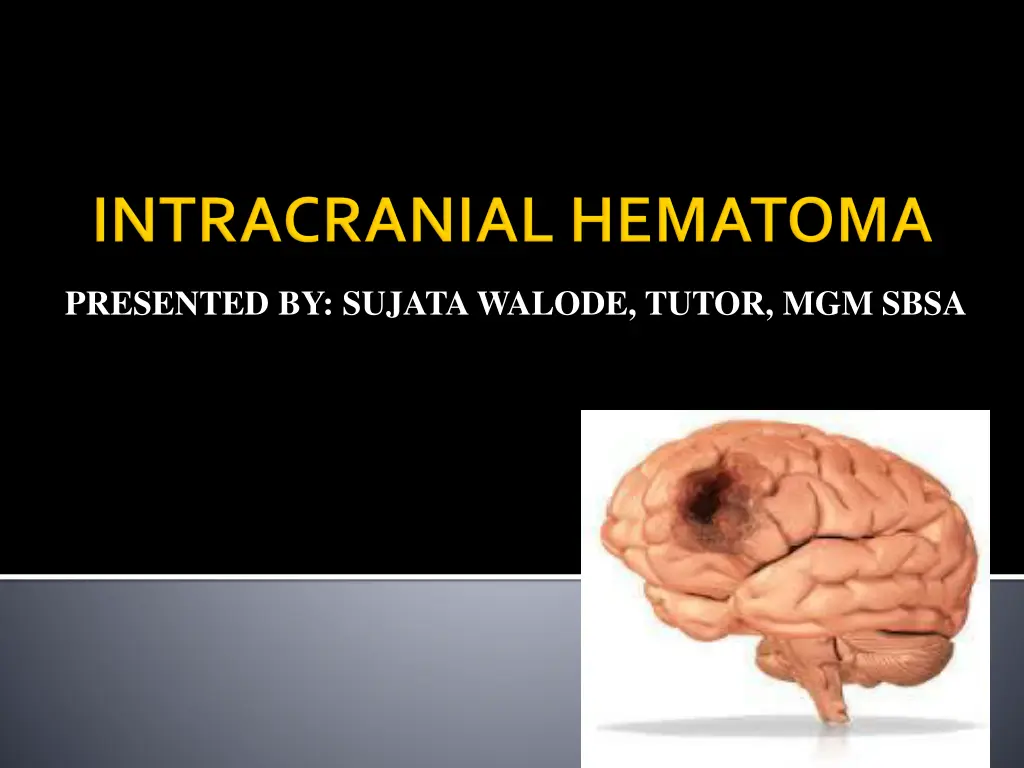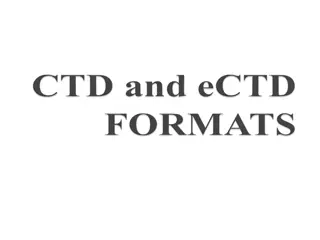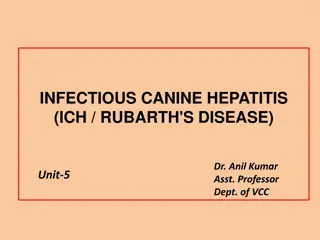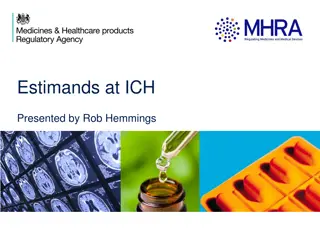
Understanding Intracranial Hemorrhage: Types, Causes, and Symptoms
Learn about the life-threatening emergency of intracranial hemorrhage (ICH) which involves acute bleeding inside the skull or brain. Explore the different types of ICH, such as epidural hematoma, subdural hematoma, subarachnoid hemorrhage, and intracerebral hemorrhage, along with their causes and symptoms. Understand the severity and implications of each type to increase awareness and prompt action in case of emergencies.
Download Presentation

Please find below an Image/Link to download the presentation.
The content on the website is provided AS IS for your information and personal use only. It may not be sold, licensed, or shared on other websites without obtaining consent from the author. If you encounter any issues during the download, it is possible that the publisher has removed the file from their server.
You are allowed to download the files provided on this website for personal or commercial use, subject to the condition that they are used lawfully. All files are the property of their respective owners.
The content on the website is provided AS IS for your information and personal use only. It may not be sold, licensed, or shared on other websites without obtaining consent from the author.
E N D
Presentation Transcript
Intracranial hemorrhage (ICH) refers to acute bleeding inside skull or brain. It s a life-threatening emergency. An intracranial hematoma is a collection of blood within the skull, most commonly caused by rupture of a blood vessel within the brain or from trauma such as a car accident or fall. The blood collection can be within the brain tissue or underneath the skull, pressing on the brain. Intracranial hemorrhage refers to any bleeding within the intracranial vault, including the brain parenchyma and surrounding meningeal spaces.
There are four types of ICH: Epidural hematoma Subdural hematoma Subarachnoid hemorrhage Intracerebral hemorrhage
Epidural hematoma A hematoma is a collection of blood, in a clot or ball, outside of a blood vessel. An epidural hematoma occurs when blood accumulates between skull and the outermost covering of brain. It typically follows a head injury, and usually with a skull fracture. High- pressure bleeding is a prominent feature. If you have an epidural hematoma, you may briefly lose consciousness and then regain consciousness. Subdural hematoma Asubdural hematoma is a collection of blood on the surface of brain. It s typically the result of head moving rapidly forward and stopping, such as in a car accident. However, it could also suggest abuse in children. This is the same type of movement a child experiences when being shaken. A subdural hematoma is more common than other ICHs in older people and people with history of heavy alcohol use.
Subarachnoid hemorrhage Asubarachnoid hemorrhage is when there s bleeding between the brain and the thin tissues that cover the brain. These tissues are called meninges. The most common cause is trauma, but it can also be caused by rupture of a major blood vessel in the brain, such as from an intracerebral aneurysm. A sudden, sharp headache usually comes before a subarachnoid hemorrhage. Typical symptoms also include loss of consciousness and vomiting. Intracerebral hemorrhage Intracerebral hemorrhage is when there s bleeding inside of your brain. This is the most common type of ICH that occurs with a stroke. It s not usually the result of injury. A prominent warning sign is the sudden onset of neurological deficit. This is a problem with your brain s functioning. The symptoms progress over minutes to hours. They include: Headache Difficulty speaking Nausea Vomiting Decreased consciousness Weakness in one part of the body Elevated blood pressure
Most ICHs are due to a head injury. Any activities or lifestyle choices that put you at risk for a head injury can lead to ICH. Factors that increase risk include: A family history of ICH Heavy alcohol use Hypertension Cigarette smoking The use of certain drugs, including amphetamines, cocaine, and MDMA (often called ecstasy ) Extreme physical exertion
The signs and symptoms of ICH vary depending on the type, but they usually include: A sudden and severe headache A headache associated with a recent blow to head A mild and long-lasting headache A headache accompanied by neck stiffness Confusion Drowsiness Vomiting more than twice in 24 hours Seizure Coma
ICH in a child can indicate child abuse. The damage may be the result of a blow to the head or by shaking the child. This can lead to shaken baby syndrome. This is a condition that occurs when violent shaking leads to serious brain damage in a child. Other signs of child abuse are: Swollen head Retinal hemorrhages Vomiting Seizure Unconsciousness Fractures of arms and legs of different ages Babies less than 12 months old may develop a swollen fontanel, or soft spot.
The first step is to diagnose ICH is a CT scan of head. ACT scan can show abnormalities in brain like swelling or clots. The CT scan may not show any sign of ICH. If symptoms persists then doctor may choose to perform a lumbar puncture, or spinal tap, to test the fluid that cushions spine and brain.
ICH is a medical emergency. Survival depends on getting treatment right away. It may be necessary to operate to relieve the pressure on the skull. Drilling a small hole in the skull releases blood. Drilling a larger hole or removing a piece of the skull may be necessary to remove a blood clot. Medications The following drugs may be necessary: Steroids to reduce swelling Anticoagulants to reduce clotting Antiseizure medications Medications to counteract any blood thinners that are been taken.
What are the complications associated with ICH? An ICH can lead to any of the following complications: Seizures Paralysis Headaches Brain development problems in children Memory loss Dizziness Difficulty concentrating How can we prevent ICH? Basic preventive measures that can help avoid head injuries include the following: Always wear a helmet when riding a bike, motorcycle, skateboard, or scooter. Always wear your seatbelt. If you re of older age, try to avoid falls.
The outlook depends on the severity of the hemorrhage and how quickly we get medical care as ICH is a life-threatening condition. Depending on the severity of the hemorrhage, draining a hematoma can lead to recovery. Physical or occupational therapy is sometimes needed to help return to normal activities






















